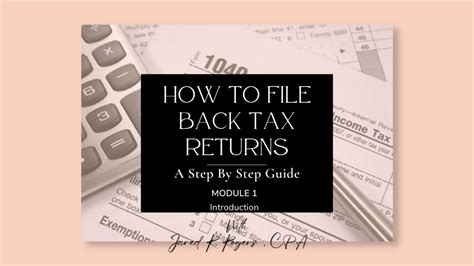How To File Old Taxes: A Comprehensive Guide
Filing old tax returns can seem daunting, but understanding the process and reasons why you might need to do so can make it manageable. This guide breaks down how to file those past-due taxes, addressing common concerns and offering helpful advice.
Why File Old Taxes?
Several reasons might necessitate filing old tax returns, even years after the deadline:
- Amended Returns: You discovered a mistake on a previously filed return and need to correct it. This requires filing an amended return (Form 1040-X).
- Unclaimed Refunds: You're entitled to a refund but haven't filed the return. The IRS has limitations on how long you can claim a refund, so act quickly!
- Back Taxes Owed: You owe back taxes and need to rectify the situation to avoid penalties and potential legal action. This is a serious matter requiring prompt attention.
- Applying for Loans or Benefits: Some loans or government benefits require proof of income, and old tax returns can provide that necessary documentation.
Gathering Necessary Documents
Before you begin, gather the following crucial documents:
- Social Security Number (SSN): This is essential for identification.
- Prior Year Tax Returns (if available): These can help you accurately complete your amended return or provide references for missing information.
- W-2 Forms: These show your wages and tax withholdings from your employers.
- 1099 Forms: These report income from freelance work, investments, or other sources.
- Receipts and Documentation for Deductions: If you're claiming deductions or credits, keep supporting documentation readily available.
How to File Amended Returns (Form 1040-X)
Filing an amended return (Form 1040-X) is necessary if you made a mistake on a previous return. Do not simply file a new return for the same year; this will create confusion.
- Obtain Form 1040-X: You can download this form from the IRS website.
- Identify the Errors: Carefully review your original return and pinpoint the mistakes.
- Complete Form 1040-X: Clearly explain the corrections you're making and provide supporting documentation.
- File Electronically or by Mail: E-filing is generally faster and more efficient. Mail the form if e-filing isn't an option.
How to File for Past-Due Taxes
Filing past-due taxes involves similar steps to filing current returns, but the process might require more careful attention to potential penalties and interest.
- Determine the Years to File: Identify all the years for which you need to file.
- Gather Necessary Documents (as listed above): Ensure you have all the required forms and information.
- File Electronically or by Mail: The IRS website offers instructions and resources for filing past-due taxes.
- Contact the IRS Directly: If you're facing significant tax debts, contacting the IRS directly to discuss payment options is crucial. They may offer payment plans to help manage your debt.
Understanding Penalties and Interest
The IRS charges penalties and interest on unpaid taxes. The amount depends on various factors, including how much you owe and how long the taxes have been overdue. Contacting a tax professional is highly recommended if you owe back taxes. They can advise on how to minimize penalties and navigate the complexities of the IRS system.
When to Seek Professional Help
While this guide provides a general overview, seeking professional help from a tax advisor or enrolled agent is strongly recommended if:
- You owe significant back taxes.
- You have complex tax situations.
- You're unsure about any aspect of the filing process.
A professional can offer personalized guidance, ensure compliance with tax laws, and help you navigate the complexities of filing old tax returns effectively. Don't hesitate to seek assistance when needed; it can save you time, money, and stress.
This comprehensive guide offers a strong foundation for filing old taxes. Remember to always maintain accurate financial records and file your taxes on time to avoid future complications.
